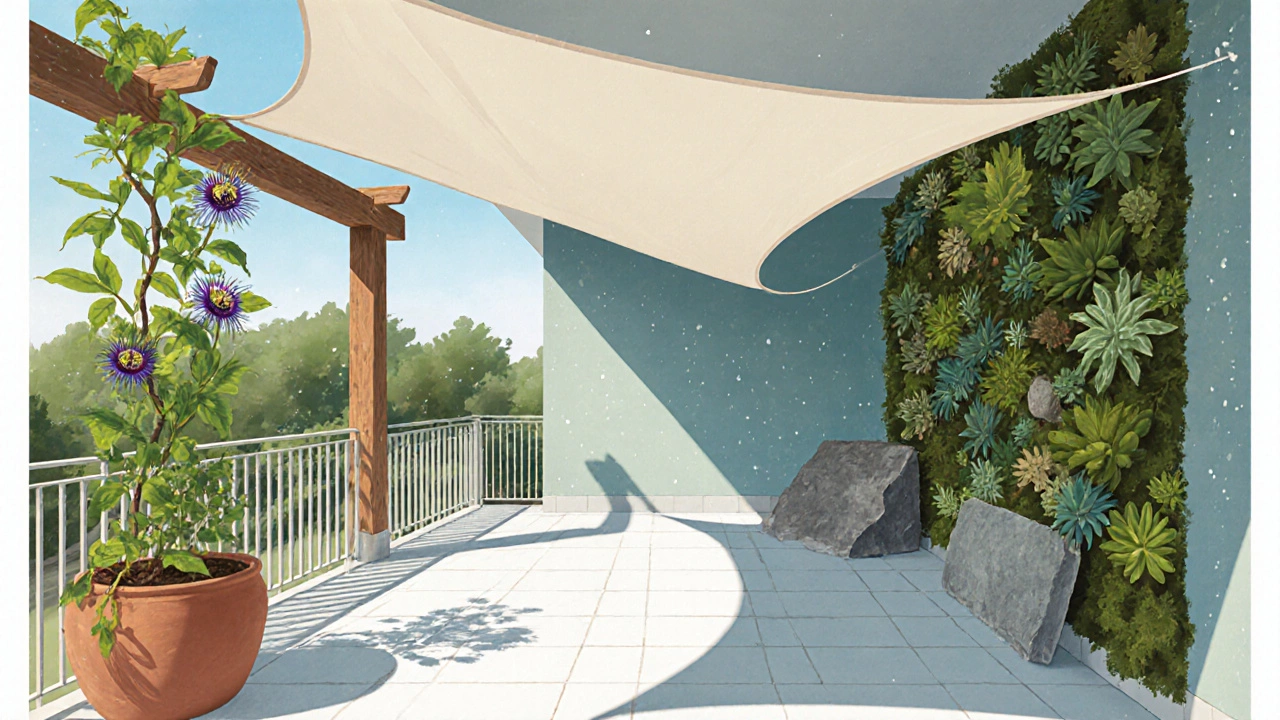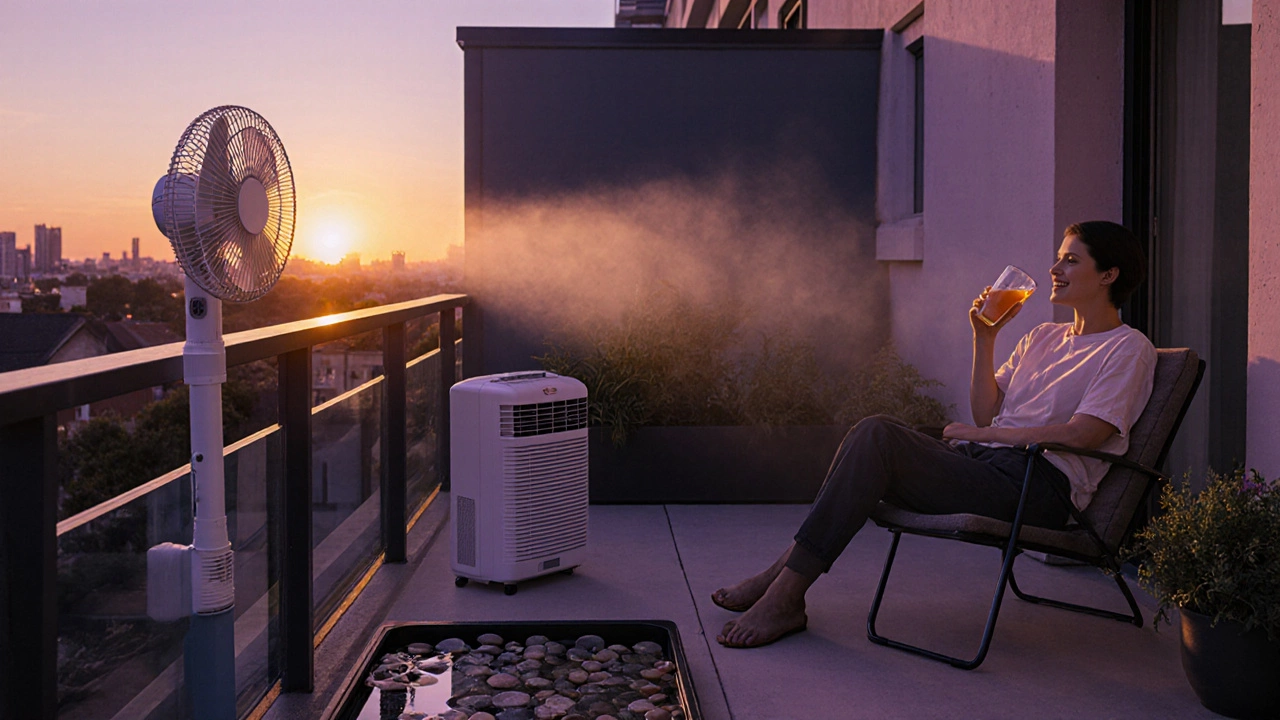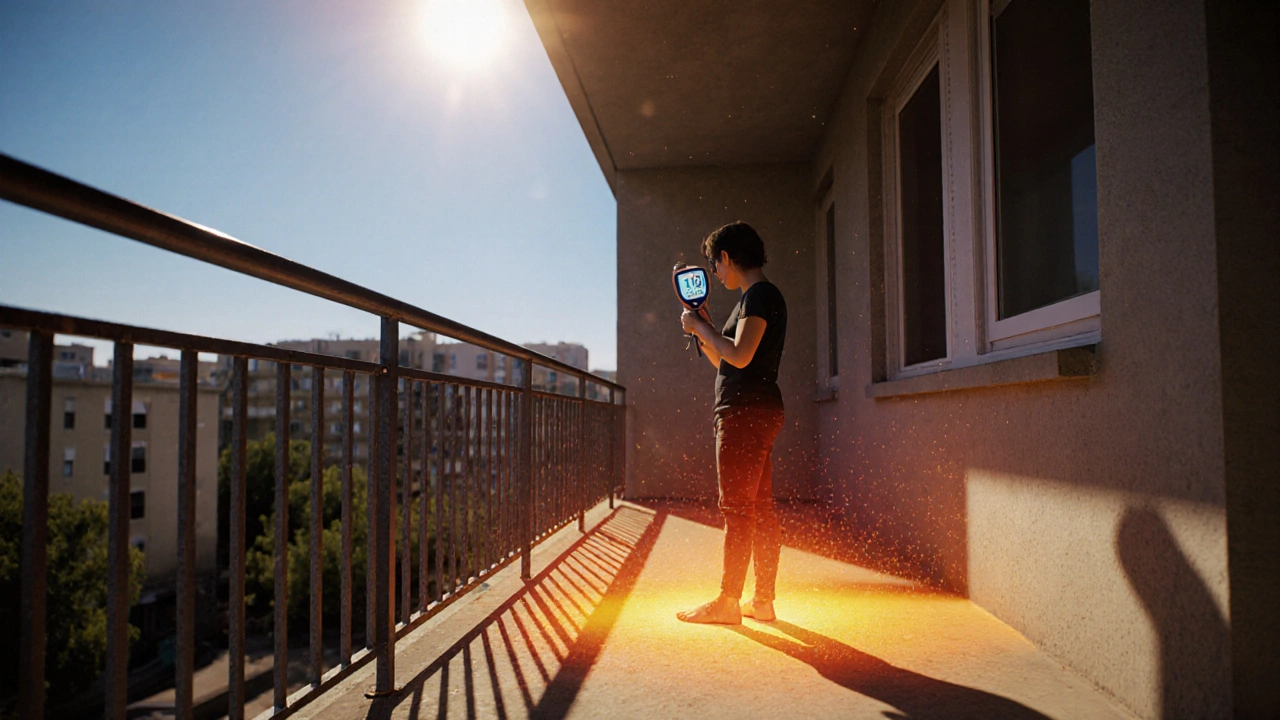Balcony Cooling Method Selector
Find Your Perfect Cooling Solution
Balcony cooling is the practice of reducing temperature on a balcony through passive and active techniques, allowing plants and people to stay comfortable during hot weather. If you’ve ever stepped onto a scorching balcony and felt the heat cling to every surface, you’re not alone. The good news is you can turn that oven‑like space into a breezy retreat without spending a fortune. Below you’ll find a step‑by‑step guide, real‑world examples, and a handy comparison table to help you pick the right method for your home.
Why Balconies Get Hot (and How to Diagnose the Problem)
Heat builds up on a balcony for three main reasons:
- Direct Sun Exposure - Most balconies face south or west, catching the strongest afternoon sun.
- Heat‑Retaining Materials - Concrete, stone, and metal absorb and re‑radiate heat long after the sun sets.
- Limited Air Flow - Narrow railings and surrounding walls block breezes that would otherwise cool the space.
Measure the temperature with a cheap infrared thermometer. If the reading is 10‑15°F (5‑8°C) higher than the indoor room, you have a clear cooling challenge.
Passive Cooling: Shade, Reflection, and Thermal Mass
Passive methods work all day and cost little to nothing. They’re the backbone of any balcony‑cooling strategy.
Shade sail
A shade sail is a fabric triangle or rectangle that stretches from the balcony railing to a wall or freestanding post. Modern sails are made from UV‑stabilized polyethylene that blocks up to 90% of solar radiation.
- Pros: Quick installation, flexible shape, high UV blockage.
- Cons: Can look bulky if not tensioned properly; wind can cause flapping.
Tip: Pick a light‑colored sail (off‑white or pastel) to reflect heat while still providing shade.
Pergola
A pergola is a wooden or metal framework that supports climbing vines or a retractable canopy. When paired with a quick‑growing vine like Passiflora (passionflower), the foliage creates a natural sunscreen.
- Pros: Adds vertical interest, improves air flow, can produce fruit or flowers.
- Cons: Higher upfront cost, needs regular pruning.
Reflective paint
Specially formulated cool‑roof paints contain ceramic microspheres that bounce sunlight away. A thin coat on the balcony floor or railing reduces heat absorption by up to 30%.
- Pros: Long‑lasting, easy DIY with a roller.
- Cons: Requires surface prep; color options are limited to light shades.
Thermal mass
Thermal mass means adding heavy, heat‑sinking objects that soak up warmth during the day and release it at night. Think large terracotta pots, stone slabs, or a water‑filled barrel placed in the shade.
- Pros: Low tech, can double as decorative elements.
- Cons: Needs space; effectiveness depends on night‑time temperature drop.
Green wall
Vertical garden panels covered in moss, succulents, or small herbs create a living blanket that evaporates water and cools the air. A simple DIY frame of lattice and potting mix can be built for under $30.
- Pros: Improves air quality, adds biodiversity.
- Cons: Requires regular watering; may add weight to the railing.
Active Cooling: Fans, Misting, and Portable Units
When the sun is relentless, passive methods alone may not be enough. Adding a bit of mechanical aid can bring the temperature down quickly.
Ventilation fan
A small, solar‑powered brushless fan mounted on the balcony rail circulates air and helps evaporative cooling from plants and water features.
- Power: 5‑10 W, usually runs on a small solar panel.
- Installation: Clip‑on brackets, no wiring needed.
Misting system
Fine‑mist nozzles spray a thin veil of water that evaporates in seconds, pulling heat from the surrounding air. Modern kits come with a timer and a rechargeable battery.
- Pros: Immediate temperature drop of 5‑10°F (3‑6°C).
- Cons: Increases humidity; watch for water damage on nearby walls.
Portable air conditioner
Mini‑window or evaporative coolers designed for balconies can be vented through a small opening. They consume 150‑300 W and provide the strongest cooling effect.
- Pros: Can lower temperature by 15‑20°F (8‑11°C).
- Cons: Higher upfront cost, needs power outlet, may need permission from building management.
Water Management and Soil Choices
Moisture is your secret weapon. Wet soil stays cooler, and plants release water through transpiration, adding a natural chill.
- Use a lightweight, well‑draining mix with perlite or coconut coir to keep water from stagnating.
- Place a shallow tray under pots and fill it with pebbles and water; the water evaporates, cooling the pots.
- Consider self‑watering containers that release moisture slowly throughout the day.

DIY Projects to Beat the Heat
Here are three quick builds you can finish in a weekend.
- DIY Shade Sail Kit: Purchase a 4 × 6 ft UV‑stable fabric, two stainless‑steel eye bolts, and turnbuckles. Attach one end to the railing, the opposite end to the wall, and tension with the turnbuckles.
- Recycled Water Barrel Cooler: Fill a 20‑liter barrel with water, paint the exterior white, and place it under a shade sail. The barrel’s mass will absorb heat and release it slowly at night.
- Solar‑Powered Mist Fan: Combine a small portable fan with a misting nozzle and a 5‑W solar panel. Mount on the railing, set the timer for 15‑minute bursts during peak sun.
Maintenance & Seasonal Adjustments
Cooling solutions need a bit of upkeep:
- Check shade sails for tears each season; replace fabric before it degrades.
- Trim vines on pergolas to keep airflow open.
- Clean misting nozzles regularly to prevent mineral buildup.
- Store portable AC units indoors during winter to protect them from frost.
Quick Checklist - Keep Your Balcony Fresh All Summer
- Measure current balcony temperature.
- Install a shade sail or reflective paint on the floor.
- Add a vertical green wall or potted herbs for evaporative cooling.
- Mount a solar‑powered fan for constant air movement.
- Consider a misting system for heat spikes.
- Use water trays under pots to boost evaporation.
- Perform monthly maintenance checks.

Frequently Asked Questions
What’s the cheapest way to cool a balcony?
A light‑colored shade sail or reflective paint on the floor costs under $30 and can cut temperatures by 5‑10°F (3‑6°C) without any electricity.
Can I use a regular garden fan on a balcony?
Yes, but a solar‑powered or low‑wattage brushless fan is safer for outdoor use and won’t overload a small balcony outlet.
Do misting systems raise humidity enough to harm my plants?
A fine mist evaporates quickly, adding only 5‑10% humidity. Most balcony plants tolerate this, but avoid misting during rain or when the balcony is already sealed.
Is it okay to drill into concrete for a pergola?
If you own the building, a few small anchors are fine. For rentals, use freestanding pergola kits that rest on the floor without drilling.
How much water should I use for a green wall?
Aim for a light mist once a day in summer. The substrate should stay damp but never soggy to prevent root rot.
Comparison of Popular Balcony‑Cooling Methods
| Method | Cost (USD) | Installation Difficulty | Cooling Effect | Maintenance |
|---|---|---|---|---|
| Shade sail | 30‑80 | Easy (30 min) | 5‑10°F drop | Check for tears annually |
| Pergola + vines | 150‑500 | Moderate (2‑3 days) | 10‑15°F drop (when vines dense) | Prune vines, inspect structure |
| Misting system | 40‑120 | Easy (1 hour) | 5‑12°F drop (instant) | Clean nozzles, monitor humidity |
| Solar fan | 20‑60 | Easy (15 min) | 3‑6°F drop (continuous) | Battery check, clean blades |
| Portable AC | 250‑600 | Moderate (30 min) | 15‑20°F drop | Filter cleaning, power use |
Pick the method (or combo) that fits your budget, time, and balcony layout. For most renters, a cool balcony solution starts with a shade sail plus a solar fan. Add a misting system on hot days, and you’ll stay comfortable from sunrise to sunset.
Take Action Today
Don’t wait for the next heat wave. Choose one passive technique, install it this weekend, and monitor the temperature change. Small upgrades add up, turning a blistering balcony into a pleasant outdoor room you’ll actually want to spend time in.

